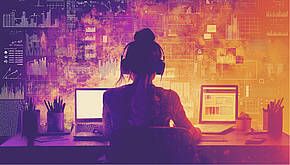- Why Us?
- Features
White Label
For SaaS Platforms & Agencies
Provide our complete analytics suite to your clients, directly within your own interface and with your/their own branding. Discover Analytics-as-a-Service and White Label Analytics. Great benefit, minimal effort.
- Pricing
- White Label
- Success Stories
- ResourcesGetting Started
CONTENTS
- What’s Ending Third-Party Cookies?
- What Will Replace Cookies in the Future?
- Building a Resilient Marketing Plan in a Cookieless World
- Smart Strategies for a Cookieless Future
- 1. Community Building and Direct Interaction
- 2. Value-Driven Content That Encourages Voluntary Interaction
- 3. Experience-Based Marketing
- 4. Cross-Brand Collaborations
- 5. Building Feedback Loops for Continuous Improvement
- Cookieless Future Advertising
- How TWIPLA Supports a Cookieless Future
- Cookieless Future FAQs
- What Is the Cookieless Future and Why Does It Matter?
- How To Combat a Cookieless Future?
- What Steps Should Brands Take to Prepare for a Cookieless Future?
What Will Replace Cookies in the Future?
As the great cookie crumble continues, businesses are facing a growing need to adopt privacy-compliant alternatives that allow them to reach audiences effectively.
Thankfully, we’re living in a fertile period for innovation.
One option involves using first-party data, whereby companies rely on data collected directly from their own website visitors.
Unlike third-party data, this information is shared voluntarily by visitors through actions like:
- Signing up for newsletters,
- filling out forms, or
- making purchases.
This approach builds website credibility and trust, as people understand they’re sharing data directly with a visible company rather than some hidden third party.
Another option is contextual ads, cookieless future advertising tailored to the content of the webpage a person is viewing, rather than through behavioral tracking methods.
Since this approach doesn’t rely on cookies, it offers a more privacy-friendly way to reach audiences.
In addition, identity solutions are also gaining traction.
Systems like Unified ID 2.0 use encrypted, anonymized data to maintain user privacy while allowing for targeted advertising across platforms.
Similarly, data clean rooms allow companies to analyze data from multiple sources in a secure environment with strict privacy controls.
In a clean room, brands can collaborate with data partners, like Google or Facebook, to access aggregated, anonymized audience insights without risking privacy violations.
Though these approaches aren’t perfect replacements, they represent a step forward in balancing privacy with the need for targeted advertising.
Finally, Google’s Privacy Sandbox is another potential alternative in the cookieless future.
This suite of tools aims to enable targeted advertising without exposing individual user data.
For example, Federated Learning of Cohorts (FLoC) groups users into anonymized “cohorts” based on shared interests, allowing brands to target ads without tracking individual users.
While the Privacy Sandbox has faced criticism and is still under development, it signals the type of innovation we can expect in a post-cookie world.
Building a Resilient Marketing Plan in a Cookieless World
There’s solace for businesses in knowing about the range of cookieless alternatives that are now available.
But to make best use of these approaches, companies need to start preparing for cookieless future realities by creating a resilient, privacy-first marketing plan.
It should prioritize both customer relationships and data integrity.
A key first step is strengthening first-party data collection, which - recap - involves gathering data directly from customers.
This data is not only more reliable than third-party data but also creates opportunities for deeper personalization and brand loyalty.
Of course, privacy compliance here means setting up strong a consent managment system around this data.
And to encourage customers to share their information willingly, businesses need to offer incentives such as exclusive content, discounts, or loyalty program memberships.
Beyond first-party data, brands can diversify their approaches by exploring new privacy-friendly strategies, like geotargeting or audience segmentation based on non-intrusive factors such as device type, time of day, or language preferences.
Investing in the right cookieless future solutions, tools and technology is also essential.
Privacy-compliant analytics is an important avenue to explore, offering features that help brands manage and analyze data while remaining privacy-compliant.
Look for data management platforms (DMPs) and customer data platforms (CDPs) that can centralize, segment, and analyze first-party data.
These tools allow brands to build and maintain a holistic view of their audience while respecting privacy regulations.
Training your marketing team on privacy best practices and ensuring everyone understands the implications of a cookieless future can help your team adapt to upcoming changes and maintain trust with your audience.
Lastly, agile marketing is crucial.
Privacy regulations and advertising technology will continue to evolve, and marketers need to keep pace.
By building flexibility into your marketing plan and staying informed about new data-collection methods, you can create a cookieless-future-proof strategy.
A resilient plan isn’t just about filling the gap left by cookies - it’s about building sustainable, privacy-conscious relationships with customers that will last well beyond the transition.
1. Community Building and Direct Interaction
Brands today can build loyalty by creating spaces where audiences feel they belong.
In a cookieless future, these community spaces -whether on social media, forums, or private groups - offer brands a way to engage without relying on tracking.
They’re places where people feel valued, free to interact with others and with the brand in ways that respect their privacy.
In these communities, brands aren’t just marketing.
They’re building genuine connections with people who share similar interests and values.
By engaging in meaningful conversations and offering spaces for shared experiences, brands can become trusted partners in these networks.
This type of relationship naturally builds loyalty, boosts word-of-mouth advocacy, and creates a positive reputation grounded in trust.
When brands create a space for people to connect on their own terms, the result is a stronger, more authentic connection - all without cookies.
2. Value-Driven Content That Encourages Voluntary Interaction
In a world without cookies, creating value-rich content is key.
Content that educates, entertains, or offers something useful can engage people on their terms.
When audiences find content that resonates, they don’t just consume it - they connect with it.
Brands that focus on providing real value build a reputation as trusted sources, drawing audiences in naturally.
This approach goes beyond tracking, inviting audiences to return for more because they genuinely want to.
As people recognize this value, they’re more likely to engage, opt into updates, and follow along voluntarily.
Value-driven content builds a mutually beneficial relationship where audiences willingly interact with the brand - all without relying on cookies or invasive tracking.
3. Experience-Based Marketing
In a cookieless world, one of the most powerful ways to engage is through experiences that people remember.
Experience-based marketing connects audiences with a brand in real time, creating authentic, lasting impressions.
Brands can create virtual events, run online challenges, or host live-streamed experiences that align with their core message and values.
These experiences don’t need to rely on data tracking to be effective; instead, they focus on creating interactions that are meaningful and fun.
When people participate in a brand-led experience, they aren’t just watching - they’re involved.
This level of involvement deepens the connection, building a sense of loyalty and affinity that no amount of tracking could replace.
For example, brands in the fitness industry might host live workout sessions, where participants feel part of a shared journey toward their goals.
These experiences can also encourage audiences to interact with each other, creating a sense of community and shared identity.
Through experience-driven marketing, brands offer something that audiences want to return to, all while respecting privacy and building trust.
4. Cross-Brand Collaborations
Strategic partnerships are an effective way for brands to broaden their audience reach while respecting privacy.
Instead of relying on tracking, these collaborations will brands to connect with new customers through shared interests long into the cookieless future.
By teaming up for co-hosted events, joint campaigns, or co-branded content, brands can engage audiences who are likely to resonate with both partners.
These partnerships are especially powerful when the brands share values or complement each other in ways that naturally attract attention.
Imagine a fitness brand joining forces with a nutrition company, offering a combined challenge that motivates and inspires participants on multiple levels.
Through these alliances, brands can reach wider audiences and build trust by focusing on authentic engagement.
With collaborative marketing, brands not only expand their reach but also create unique experiences.
5. Building Feedback Loops for Continuous Improvement
Direct feedback is more than just a tool - it’s a conversation, a way to let customers shape the very brand they support.
Inviting people to share their thoughts through surveys, polls, or open sessions gives them a voice and a stake in the brand’s journey.
When a brand asks what features customers value or which improvements they want to see, it becomes a collaboration rather than a transaction.
People don’t just feel heard; they feel respected, knowing their opinions can directly influence future products.
For the brand, these insights are invaluable, offering a compass without the need for intrusive tracking.
This approach doesn’t just improve the product - it builds loyalty, creating a bond based on mutual trust and genuine involvement.
What Is the Cookieless Future and Why Does It Matter?
The cookieless future refers to the phase-out of third-party cookies due to privacy concerns, changing how advertisers track user behavior and collect data. This shift emphasizes privacy-first strategies and reshapes digital advertising practices.
How To Combat a Cookieless Future?
To prepare, brands should focus on collecting first-party data, enhancing customer trust, and exploring cookieless targeting methods like contextual advertising. Investing in privacy-compliant tools and adapting strategies now will ease the transition into a cookieless world.
What Steps Should Brands Take to Prepare for a Cookieless Future?
Brands should invest in first-party data collection, update attribution models, and adopt privacy-friendly technologies. Building transparent, privacy-first marketing strategies now prepares brands for long-term success in a cookieless world.
Share article
Get Started for Free
Gain World-Class Insights & Offer Innovative Privacy & Security

You might also like
Interview: Orbit Media CEO Andy Crestodina 20 September 2024 - by TWIPLA Staff
20 September 2024 - by TWIPLA Staff
Weebly.com: How to Build Your Square Website Successfully 04 September 2023 - by Simon Coulthard
04 September 2023 - by Simon Coulthard















